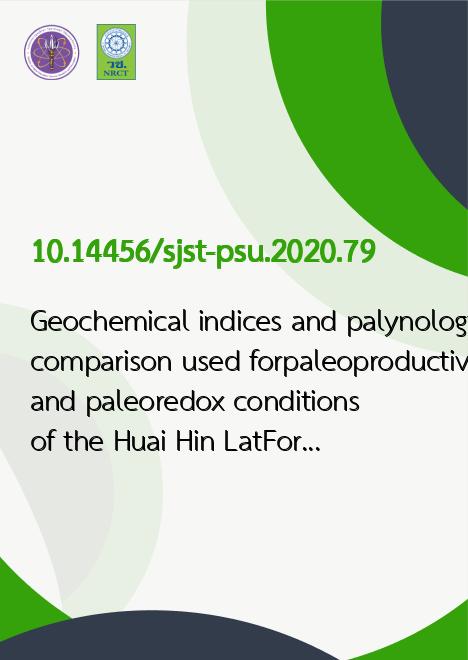
|
Geochemical indices and palynology comparison used forpaleoproductivity and paleoredox conditions of the Huai Hin LatFormation in part of Loei-Petchabun Fold Belt in central Thailand |
|---|---|
| รหัสดีโอไอ | |
| Creator | 1. Boonnarong Arsairai 2. Qinglai Feng 3. Chongpan Chonglakmani 4. Akkhapun Wannakomol 5. Hathaichanok Vattanasa |
| Title | Geochemical indices and palynology comparison used forpaleoproductivity and paleoredox conditions of the Huai Hin LatFormation in part of Loei-Petchabun Fold Belt in central Thailand |
| Publisher | Research and Development Office, Prince of Songkla University |
| Publication Year | 2563 |
| Journal Title | Songklanakarin Journal of Science and Technology |
| Journal Vol. | 42 |
| Journal No. | 3 |
| Page no. | 621-630 |
| Keyword | TOC, hydrocarbon, geochemistry, kerogen, petrography, Huai Hin Lat Formation |
| URL Website | https://rdo.psu.ac.th/sjstweb/index.php |
| ISSN | 0125-3395 |
| Abstract | Petrography and geochemistry analyzing Dat Yai section can describe paleoproductivity and past-redox condition.Paleoproductivity proxies consisted of AOM, phytoclast, TOC, excess SiO2, Ba/Al, and P/Al as high values through sectionswhich similarly indicate high productivity. High productivity in Beds 3 and 27 showed lower peak TOC which is explained bypoorer preservation. Lower productivity of Bed 18 showed a high TOC peak indicating good preservation. Paleoredox conditionwas evaluated using Ni/Co, U/Th, V/Cr, V/(V+Ni), Ni/V, and (Cu+Mo)/Zn. Values for V/(V+Ni) ranged from 0.67 to 0.85exceeding the cutoff value of 0.46 for a reducing environment. The average value of V/Cr (2.07) exceeded 2.0 of anoxic. Bed 9consisted of the highest peak of TOC that does not reflect the excellent preservation resulting from dominantly highpaleoproductivity. Bed 21 exhibited lower productivity and lowest TOC which indicated a poverty-reducing effect. AOM andphytoclasts were supplied and kept in the benthic floor by extreme redox. Sediments became black shale which expelled oil andsome gas. |
